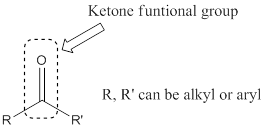
Concept explainers
(a)
Interpretation:
The model structure has to be converted into line drawing along with identification of Functional Group.
Concept Introduction:
Line structure is a simple and quick way to represent organic molecules without showing carbons and hydrogens present. Drawing a molecule in this way is very simple:
It follows the following guide line:
- Each carbon- carbon bond is represented by a line.
- Anywhere a line ends or begins, as well as any vertex where two lines meet represents a carbon atom.
- Any atom other than another’s carbon or hydrogen attached to a carbon must be shown.
- Since a neutral carbon atom form four bonds, all bonds not shown for any carbon are understood to be the number of carbon – hydrogen bonds needed to have.
Functional group: Organic compounds can be classified into various families according to the


Ether: A class of organic compounds, where oxygen is attached to two alkyl or aryl groups.

(b)
Interpretation:
The model structure has to be converted into line drawing along with identification of Functional Group.
Concept Introduction:
Line structure is a simple and quick way to represent organic molecules without showing carbons and hydrogens present. Drawing a molecule in this way is very simple:
It follows the following guide line:
- Each carbon- carbon bond is represented by a line.
- Anywhere a line ends or begins, as well as any vertex where two lines meet represents a carbon atom.
- Any atom other than another’s carbon or hydrogen attached to a carbon must be shown.
- Since a neutral carbon atom form four bonds, all bonds not shown for any carbon are understood to be the number of carbon – hydrogen bonds needed to have.
Functional group: Organic compounds can be classified into various families according to the functional groups they contain a functional group is a part of a larger molecule and is composed of a group of atoms that has characteristic structure and chemical reactivity.
Functional group:
An atom or group of atoms which has physical and chemical properties is known as functional group.
Ketone: A compound containing a carbonyl group

Alkene: Unsaturated hydrocarbons containing double bonds.

Ether: A class of organic compounds, where oxygen is attached to two alkyl or aryl groups.

Want to see the full answer?
Check out a sample textbook solution
Chapter 12 Solutions
Fundamentals of General, Organic, and Biological Chemistry (8th Edition)
- Which type of enzyme catalyses the following reaction? oxidoreductase, transferase, hydrolase, lyase, isomerase, or ligase.arrow_forward+NH+ CO₂ +P H₂N + ATP H₂N NH₂ +ADParrow_forwardWhich type of enzyme catalyses the following reaction? oxidoreductase, transferase, hydrolase, lyase, isomerase, or ligase.arrow_forward
- Which features of the curves in Figure 30-2 indicates that the enzyme is not consumed in the overall reaction? ES is lower in energy that E + S and EP is lower in energy than E + P. What does this tell you about the stability of ES versus E + S and EP versus E + P.arrow_forwardLooking at the figure 30-5 what intermolecular forces are present between the substrate and the enzyme and the substrate and cofactors.arrow_forwardprovide short answers to the followings Urgent!arrow_forward
- Pyruvate is accepted into the TCA cycle by a “feeder” reaction using the pyruvatedehydrogenase complex, resulting in acetyl-CoA and CO2. Provide a full mechanismfor this reaction utilizing the TPP cofactor. Include the roles of all cofactors.arrow_forwardB- Vitamins are converted readily into important metabolic cofactors. Deficiency inany one of them has serious side effects. a. The disease beriberi results from a vitamin B 1 (Thiamine) deficiency and ischaracterized by cardiac and neurological symptoms. One key diagnostic forthis disease is an increased level of pyruvate and α-ketoglutarate in thebloodstream. How does this vitamin deficiency lead to increased serumlevels of these factors? b. What would you expect the effect on the TCA intermediates for a patientsuffering from vitamin B 5 deficiency? c. What would you expect the effect on the TCA intermediates for a patientsuffering from vitamin B 2 /B 3 deficiency?arrow_forwardDraw the Krebs Cycle and show the entry points for the amino acids Alanine,Glutamic Acid, Asparagine, and Valine into the Krebs Cycle - (Draw the Mechanism). How many rounds of Krebs will be required to waste all Carbons of Glutamic Acidas CO2?arrow_forward
 Principles Of Radiographic Imaging: An Art And A ...Health & NutritionISBN:9781337711067Author:Richard R. Carlton, Arlene M. Adler, Vesna BalacPublisher:Cengage Learning
Principles Of Radiographic Imaging: An Art And A ...Health & NutritionISBN:9781337711067Author:Richard R. Carlton, Arlene M. Adler, Vesna BalacPublisher:Cengage Learning Biology (MindTap Course List)BiologyISBN:9781337392938Author:Eldra Solomon, Charles Martin, Diana W. Martin, Linda R. BergPublisher:Cengage Learning
Biology (MindTap Course List)BiologyISBN:9781337392938Author:Eldra Solomon, Charles Martin, Diana W. Martin, Linda R. BergPublisher:Cengage Learning





